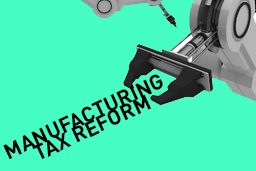The following are a few interesting facts about the U.S. manufacturing sector from the National Association of Manufacturer’s Top 20 Facts About Manufacturing:
- In the most recent data, manufacturers contributed $2.33 trillion to the U.S. economy in the first quarter of 2018. This figure has risen since the second quarter of 2009 when the manufacturers’ contributed $1.70 trillion.
- For every $1.00 spent in manufacturing, another $1.89 is added to the economy through the extensive supply chain in this sector.
- The vast majority of the manufacturing firms in the United States are quite small. As of the most recent data available, there were 251,901 firms in the manufacturing sector, with 98% (all but 3,813 firms) considered to be small (i.e. having fewer than 500 employees).
- Manufacturers have experienced tremendous growth over the past couple of decades, encouraging leaner operations in order to become more competitive globally.
- Over the past 25 years, U.S. manufactured goods exports have quadrupled.
- Taken alone, manufacturing in the United States would be the ninth-largest economy in the world.
- Foreign direct investment in U.S. manufacturing exceeded $1.6 trillion for the first time ever in 2017.
- In 2015, the average manufacturing worker in the United States earned $81,289 annually, including pay and benefits. The average worker in all nonfarm industries earned $63,830.
In looking at these facts, it is no wonder Congress has enacted tax legislation that is favorable toward manufacturers. The question is, are you taking full advantage of the benefits available under the tax law including the new tax legislation, the Tax Cuts and Jobs Acts of 2017 (“TCJA”)?
If you are a manufacturing company, you should be asking yourself the following questions:
1) Are you taking advantage of the research and development credit?
If you are engaging in research and development are you taking advantage of the Research & Experimentation Tax Credit (a.k.a. the R&D Tax Credit)? For many years, to claim this credit you had to be researching the development of a new product. A few years ago, the credit was expanded to include process development and experimentation. This is a tax credit that can either be taken at the corporate level or at the shareholder level for pass-through entities.
Another change impacting smaller manufacturing entities is the elimination of the alternative minimum tax limitation that limited the benefit for many manufacturing companies and their shareholders. The credit is typically based on wages for the personnel involved in the activity and would include any supplies expended in the development process. In order for the costs to qualify as research and development costs, the company cannot be reimbursed or paid for their investment. Since this is a tax credit that can reduce tax liability dollar for dollar, this is something all manufacturing companies should be looking into.
2) Are you taking full advantage of Bonus Depreciation?
Bonus depreciation allows for the immediate expensing of a portion of the cost of qualified property to be deducted in a single year. For tax years prior to January 1, 2018, companies were allowed to take 50% bonus depreciation on qualified property. Under the TCJA, companies will be permitted a 100% bonus depreciation on qualified property placed in service after September 23, 2017. This will be a significant benefit to manufacturing companies that are capital intensive. As a result, manufacturing entities and their shareholders would benefit from some early tax planning this year to avoid overpayment of 2018 taxes.
3) Have you placed real property in service over the past couple of years?
If you have made improvements to your building in the recent past or purchased new facilities recently, have you considered a cost segregation study to accelerate your depreciation deduction? A building is made up of many components that have different tax lives. The structural components of the building would be considered buildings and improvements that have a 39-year tax life. However, there are other components that would have tax lives much shorter than 39 years. For instance, a parking lot would be considered land improvements, subject to 15-year tax life. Another example would be the electrical line installed to power a new piece of manufacturing equipment, which would qualify as part of the equipment and could qualify for a 5 or 7 year tax life depending on the equipment. A cost segregation study would go through the various components of the building and break them down into the various components so they can be depreciated separately. These studies can be performed after the fact, even if the building has been placed in service years ago. If the asset was placed in service in the past, the cost segregation study calculates the amount of depreciation that would have been allowed if the building was properly componentized. The difference between the depreciation per the cost segregation study and what was actually taken yields a current year tax deduction. Given the fact that the TCJA has reduced the tax rates going forward, 2017 would be a good year to undertake a cost segregation study and maximize the tax dollar savings of any adjustment.
4) Have you reviewed your state tax filings recently to determine your correct state tax filings?
Over that past several years, many states have been very aggressive in trying to pull out-of-state companies into their state from a tax perspective. Traditionally, in order for a company to have nexus in another state, a company had to have employees or property physically in that state. However, over the past few years, states have been moving toward an economic nexus. This means that if a company has sales in a state above a base level (this amount varies from state to state), the company is considered to have nexus in a state and must file and pay income taxes in that state. Thus, you no longer need a physical presence in a state in order to have nexus in a state. Companies should undertake a state and local tax nexus study to ensure that the proper tax returns are being filed. Typically, companies are permitted to allocate their income based upon a business allocation factor. Many states have switched to market base sourcing for sales of tangible personal property. A yearly review of allocation factors and sourcing rules should be undertaken. However, if the proper income tax returns are not filed, the statute of limitations does not begin and a situation could arise where the home state tax credit will not be available because the tax year has closed. The states vary on how far they go back once they identify an entity who failed to file a tax return in their state, but it can range from 4 to 7 years in many cases.
5) Do you have a foreign subsidiary or are you owned by a foreign entity?
As indicated above, foreign direct investment in manufacturing has grown rapidly over the past several years. For U.S. manufacturers owned by a foreign parent or U.S. manufacturers that own foreign operations, there are onerous reporting obligations. If these reporting obligations are not met, the consequences could be very costly. Entities must report financial transactions with foreign parents and foreign subsidiaries. A separate form must be filed for each entity with whom the U.S. company is conducting business. Therefore, if a U.S. company is conducting business with four foreign subsidiaries, the U.S. company must report the transactions with a related party on separate federal forms. Failure to report these transactions properly and completely could result in a penalty of $10,000 per form per year. Under the TCJA these penalties have been increased to $25,000 per form per year. Based on the size of the penalties, failure to properly report foreign transactions could result in substantial penalties being assessed. The good news is that there are programs available for taxpayers to file past forms and get relief from the penalties.
6) What are you doing if anything for sales tax?
Although most manufacturing companies have a wide manufacturing exemption on purchases made and used in the manufacturing process, there are limitations set by the States based on the proximity of the equipment and their usage in the manufacturing process. More often than not manufacturers claim the manufacturing exemption on purchases that are not part of the manufacturing exemption. By doing so the companies create a use tax exposure that in turn can create a use tax liability plus interest and penalties if there is an audit.
However, over the past ten years or so as manufacturing companies in many different industries have tried to improve margins, sales and differentiate themselves by adding value-add services to their products. If you currently selling services in conjunction with products, you may be entering in a complex area of sales tax. States treat services sold in connection with products differently in every state, and it consequently creates room for errors.
It is crucial that manufacturers have a process in place for exemption/resale certificates to support their exemption certificate. They should be reviewed for accuracy and updated frequently. Every state has its own requirement and forms needed to substantiate the exemption.
As if the world of sales tax didn’t create enough uncertainties for the manufacturers, it recently got more complicated. On June 21, 2018, the U.S. Supreme Court decided in a landmark case to overturn the long-standing physical presence requirement in South Dakota v. Wayfair. The Court ruled that South Dakota can require out-of-state retailers to collect tax on sales to South Dakota customers, despite having no physical presence in the state. The Supreme court noted establishing a threshold of $100,000 of revenue a year or 200 transactions met the four-prong test of the Commerce Clause.
Many states have reacted and have issued similar guidance. Given the fact that most states are looking to close budget holes more states will most likely follow suit and enact similar regulations. Sales tax can be very complicated and if mistakes are made they can be very costly. It is crucial now more than ever before a sales tax analysis is done to make sure that overpayment and/or underpayments can be managed accordingly.
7) Have you been taking advantage of the domestic production activities deduction (DPAD)?
Although the TCJA has eliminated the DPAD deduction effective January 1, 2018, it is still may not too late to go back and take the deduction for the tax year 2017, 2016 and 2015 if it was not claimed or calculated incorrectly. For the tax years through 2017, 9% of the total net income from U.S.-produced goods is permitted as a deduction for federal income tax purposes. To qualify as domestically produced goods, at least 20% of the total cost must be from U.S. based direct labor and overhead costs. Besides missing the deduction a common mistake is not calculating the eligible sales correctly.
This list is not intended to be comprehensive, but rather highlights potential savings and potential pitfalls. Consider if your company has potential tax exposure in any of these areas, or if can you benefit for any of these tax-saving strategies. Withum has a broad range of expertise in tax issues regarding manufacturing companies. We are ready to answer any questions.
Manufacturing, Distribution & Logistics
How Can We Help?







